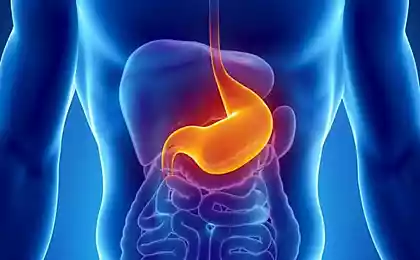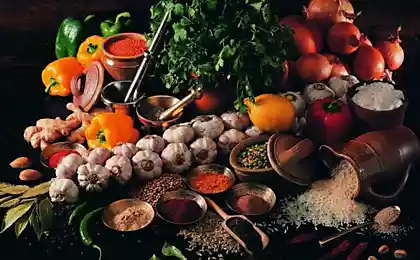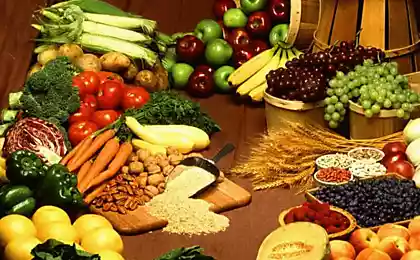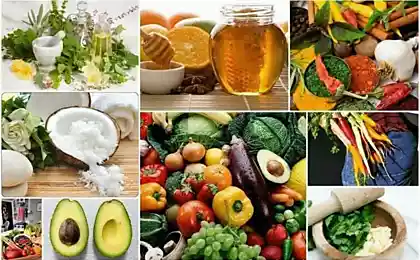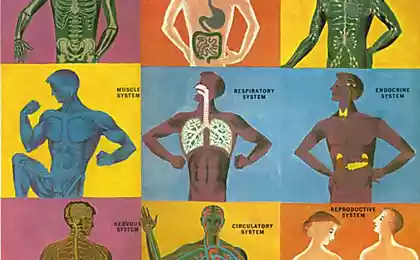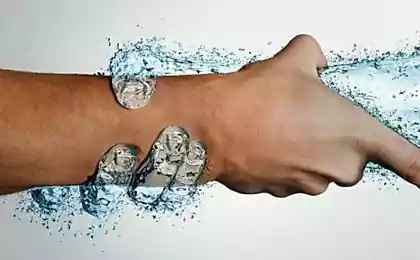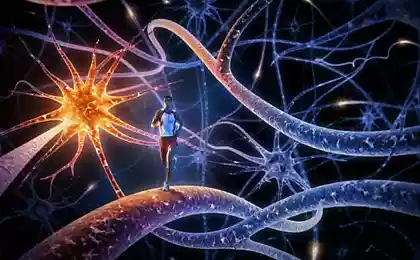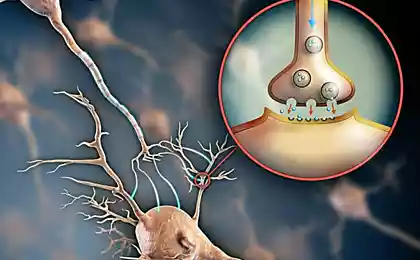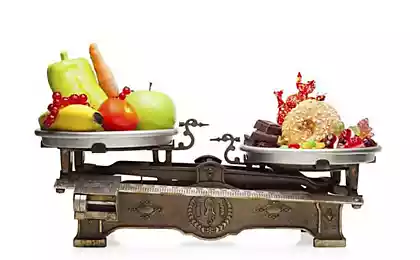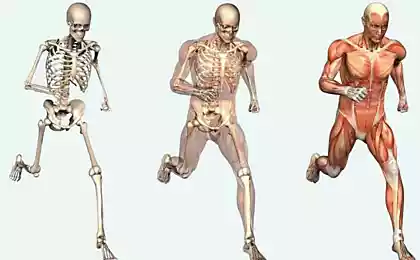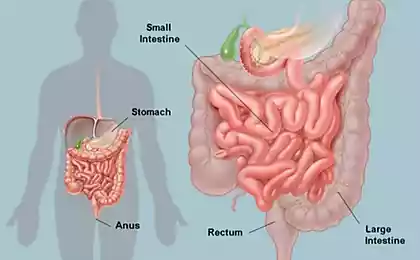500
How is digestion in the body
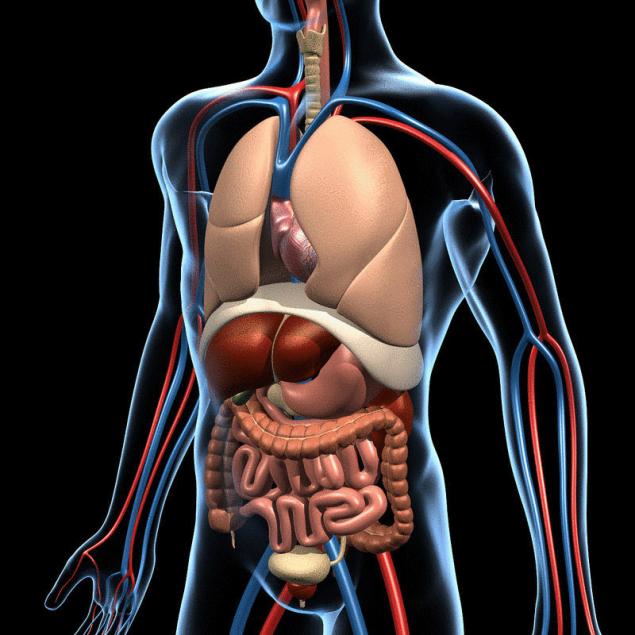
Must be nice, to have some predstavlenie about the structure of our digestive system and what happens to food inside.
A man who knows how to cook, but not knowing what fate awaits his dishes after they have eaten, is likened to a motorist who has learned the traffic rules and learn to "spin the wheel", but knows nothing about the device. To go on a long journey with such knowledge is risky, even if the machine is completely reliable. In the way there are all sorts of surprises.
Consider the General structure of the "digestive machinery".
So, take a look at the diagram.
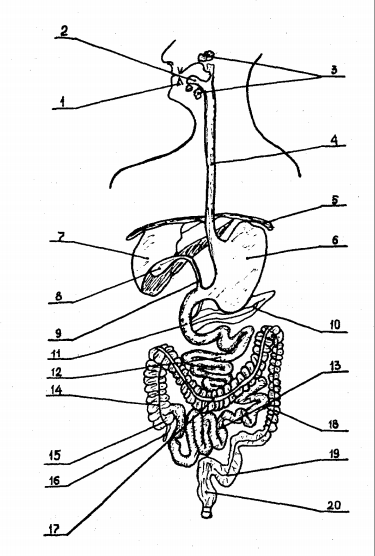
We took a bite of something edible.
Have sobotkova teeth (1) and they continue to chew. Even purely physical grinding plays a huge role – food should enter the stomach in the form of a slurry, it is digested in chunks of tens and even hundreds of times worse. However, doubting the role of the teeth can try something to eat, not taking and not grinding their food.
LANGUAGE AND Lunapro chewing is also soaked with saliva, secreted by three pairs of major salivary glands (3) and many smaller ones. A day is normally produced by from 0.5 to 2 liters of saliva. Its enzymes mainly break down krahmal! With proper chewing of a homogeneous liquid mass, requiring minimal costs for further digestion.
In addition to chemical exposure to food, saliva has antibacterial properties. Even in between meals it always moistens the mouth and protects the mucous membrane from drying out and contributes to its disinfection. No accident with minor scrapes, cuts the first natural movement is to lick the wound. Of course, saliva as a disinfectant for reliability inferior peroxide or iodine, but is always at hand (i.e. in your mouth).
Finally, our language (2) accurately determines, tasty or tasteless, sweet or bitter, salty or sour. These signals serve as indication of how much and what kind of juices you need to digest.
Pedestrianonly food through the mouth into the esophagus (4). Swallowing is a rather complex process, involving many muscles, and to a certain extent it is a reflex.
The esophagus is a four-layer tube length of 22-30 cm In a resting state, the esophagus has a clearance in the form of a slot, but eaten and drunk by no means falls down, and is moving due to the wave-like contractions of its walls. All this time actively pursued the salivary digestion.
Glucosaine digestive organs are in the abdomen. They are separated from the thorax by the diaphragm (5) is the main respiratory muscle. Through a special hole in the diaphragm the esophagus enters the abdominal cavity and goes into the stomach (6).
This hollow body shaped like a retort. On its inner mucous surface is several folds. The volume of completely empty stomach about 50 ml. When eating it expands and can hold quite a lot — up to 3-4 L.
So, swallowed food in the stomach. Further transformation is determined primarily by its composition and quantity. Glucose, alcohol, salt, and excess water can immediately be absorbed depending on the concentration and combination with other products. The bulk eaten is subjected to the action of gastric juice. This juice contains hydrochloric acid, several enzymes and mucus. It stands out for its special glands in the mucosa of the stomach, which has about 35 million.
Moreover, the composition of the juice is different every time for every food your juice. Interestingly, the stomach, as if in advance knows what he's facing, and highlights the need juice sometimes long before the food is at the sight or smell of food. It proved another academician I. P. Pavlov in his famous experiments with dogs. And the man juice stands out even in distinct thoughts about food.
Fruit, yogurt and other light foods require quite a bit of juice of low acidity and with a small number of enzymes. Meat, especially with spicy seasonings, causes profuse secretion is very strong juice. Relatively weak but extremely rich in enzymes the juice produced bread.
Total for the day stands at an average of 2-2. 5 liters of gastric juice. An empty stomach is periodically reduced. Everyone feels "hungry spasms". Eaten well for some time and stops the motor. This is an important fact. Because each portion of food coats the inner surface of the stomach and is in the form of a cone, attached to the previous one. The gastric juice acts mainly on superficial layers in contact with the lining of the shell. Inside for a long time to work the enzymes of saliva.
Enzymes are substances of protein nature, ensuring the occurrence of any reaction. The main enzyme of gastric juice – pepsin, are responsible for the breakdown of proteins.
DUODENUM, Kickapo as digestion of food portion located at the walls of the stomach, moving towards the exit from it – to the gatekeeper. Thanks to renewed by this time, the motor function of the stomach, that is, its periodic contractions, the food is thoroughly mixed. As a result, in the duodenum (11) goes for almost poluperiferiinye homogeneous slurry. The pylorus guards the entrance to the duodenum. This muscular valve, passing the food mass in only one direction.
The duodenum refers to the small intestine. In fact, the entire digestive tract starting from the pharynx and down to the anus, is a tube with a variety of bulges (even such large as the stomach), lots of bends, loops, multiple sphincters (valves). But parts of the tube stand and an anatomically and performed in the digestion functions. So, I think the small intestine consisting of the duodenum (11), jejunum (12) and the ileum (13).
The duodenum is the thickest, but its length is only 25-30 cm, Its inner surface covered with many villi and in the submucosa there are small glands. Their secret contributes to the further breakdown of proteins and carbohydrates.
In the cavity of the duodenum open the common bile duct and main pancreatic duct.
Piceno, the bile duct comes bile produced by the largest gland of the body – liver (7). Per day the liver produces about 1 l of bile – quite an impressive number. Bile is composed of water, fatty acids, cholesterol, and inorganic substances.
Bile starts 5-10 minutes after you start eating and ends when the last bit of food leaves the stomach. Bile stops the action of gastric juice, due to which the gastric digestion is replaced by intestinal. It also emulsifies fats – make emulsion, increasing the multiple contact surface of the fat particles with the induced enzymes.
GALL PUZYREV her task is to improve the absorption of products of digestion of fats and other nutrients – amino acids, vitamins, to promote the food of the masses and prevent their decay. Stocks of bile stored in the gallbladder (8). The most actively shrinking its bottom adjacent to the pylorus part. Capacity about 40 ml, however, the bile is a concentrated form, shumas 3-5 times compared with hepatic bile. If necessary, it flows through the cystic duct, which unites with the hepatic duct. Formed by common bile duct (9) and delivers bile into the duodenum.
Same goes Relesased PANCREAS pancreatic duct (10). It is the second largest gland in human. Its length is 15-22 cm and a weight of 60-100 grams. Strictly speaking, the pancreas consists of two glands – exocrine-producing a day 500-700 ml of pancreatic juice and endocrine, which produces hormones.
The difference between these two types of glands is that the secret of exocrine glands (glands of external secretion) secreted into the external environment, in this case, in the cavity of the duodenum, and produced by endocrine (i.e., endocrine) glands substances, called hormones, enter the blood or lymph.
Pancreatic juice contains a complex of enzymes that break down all food compounds proteins and fats, and carbohydrates. This juice is allocated each time a "starvation" spasm of the stomach, continuous delivery starts in a few minutes after you start eating. The composition of the juice varies with the nature of the food.
Pancreatic hormones — insulin, glucagon, etc. regulate carbohydrate and fat metabolism. Insulin, for example, stops the breakdown of glycogen (animal starch) in liver and translates the cells of the body to food, mainly glucose. The sugar level in the blood is lowered.
But back to the transformations of food. In the duodenum it is mixed with bile and pancreatic juice. Bile suspends the action of gastric enzymes and ensures proper work of the pancreatic juice. Proteins, fats and carbohydrates are further digested. Excess water, mineral salts, vitamins and completely digested substances are absorbed through the intestinal wall.
Kishechnikom curving, duodenum passes into the skinny (12), length 2-2,5 m. the Latter in turn connects with the ileum (13), the length of which is 2.5-3.5 m. the Total length of the small intestine is thus 5-6 m. Its absorptivity multiplied due to the presence of transverse folds, the number of which reaches 600-650. In addition, the inner surface of the intestine is lined with numerous villi. Coordinated movements provide the passage of food masses through them absorbed nutrients.
Previously it was thought that the intestinal absorption process is purely mechanical. That is, it was assumed that nutrients are broken down into the elementary "bricks" in the cavity of the intestine, and then these "building blocks" to penetrate into the bloodstream through the intestinal wall.
But it turned out that in the intestine food compounds "understand" not to the end, and the final cleavage occurs only near the walls of the intestinal cells. This process was called a membrane, or parietal
What is it? Nutrients are pretty crushed in the intestine under action of pancreatic juice and bile, penetrate between the villi of the intestinal cells. Moreover, the villi form a dense fringe, that for large molecules, and the more bacteria, the surface of the intestine available.
In this sterile area of the intestinal cells secrete numerous enzymes, and the fragments of the nutrients are divided into elementary components – amino acids, fatty acids, monosaccharides and absorbed. And the digestion and absorption happen in a very limited space and are often combined into one complex interrelated process.
One way or another for five metres of the small intestine the food is digested completely and the resulting substances in the blood. But they do not in General circulation. If that happened, people would die after the first meal. All the blood from the stomach and intestines (thin and thick) going into the portal vein and goes to liver. After all, food provides not only a useful compound, in its cleavage produces many by-products. Here it is necessary to add the toxins of intestinal microflora, and many drugs, and poisons present in foods (especially in a modern environment). And purely nutritional components should not immediately get into the General blood stream, otherwise their concentration would exceed all limits.
The position rescues the liver. It is not for nothing called the main chemical laboratory of the body. Here is the disinfection of harmful compounds and regulation of protein, fat and carbohydrate metabolism. All of these substances can be synthesized and degraded in the liver — according to need, ensuring the constancy of our internal environment.
The intensity of her work can be seen in the fact that with weight of 1.5 kg, the liver spends about a seventh of the whole produced by the body energy. A minute passes through the liver about one and a half liters of blood, and its vessels can be up to 20% of the total amount of blood in humans. But make sure to end the path of food.
From the ileum through a special valve that prevents back leaking, undigested residues fall into the colon. Upholstered its length 1.5 to 2 metres. Anatomically it is divided into the cecum (15) and vermiform Appendix (Appendix) (16), ascending colon (14), transverse colon (17), descending colon (18), sigmoid colon (19) and direct (20).
In the large intestine completes the absorption of water and forms the feces. To do this, intestinal cells are indicated by a special mucus. In the colon shelter a myriad of microorganisms. Select the feces approximately one-third consists of bacteria. Not to say that it's bad. Because the norm is established in a symbiotic relationship of the owner and his "tenants." The microflora feeds on the waste, and delivers vitamins, some enzymes, amino acids and other necessary substances. In addition, the constant presence of microbes maintains the health of the immune system, not allowing it to "doze off". Even the "permanent inhabitants" do not allow the introduction of outsiders, often pathogenic.
But this picture is rosy only happen with a proper diet. Unnatural, refined products, excess food and wrong combinations change the composition of the microflora. Predominate over putrefactive bacteria, and instead of vitamins, the person receives poisons. Badly beaten on the microflora and various drugs, particularly antibiotics.
But somehow fecal matter moving through undulating movements of the colon — peristalsis and reaches the rectum. Its output for hedging there are two whole sphincter — inner and outer, which are short of anus, opening only during defecation.
In the mixed food from the small intestine in fat per day on average, passes about 4 kg of food masses, of feces also produced only 150-250 g But vegetarians feces formed much more because of their food a lot of ballast substances. But the gut works perfectly, microflora is established the most friendly, and poisonous products a significant part of not even reach the liver, absorbed in the fiber, pectin and other fibres.
We will finish our tour of the digestive system. But it should be noted that its role is not confined only to digest. In our body everything is interconnected and interdependent on both the physical and energy plans.
Recently, for example, found that the gut is a powerful apparatus for the production of hormones. Moreover, the volume of the synthesized substances it is comparable (!) with all the other endocrine glands together.
source: eggheado.com
Source: /users/1077


